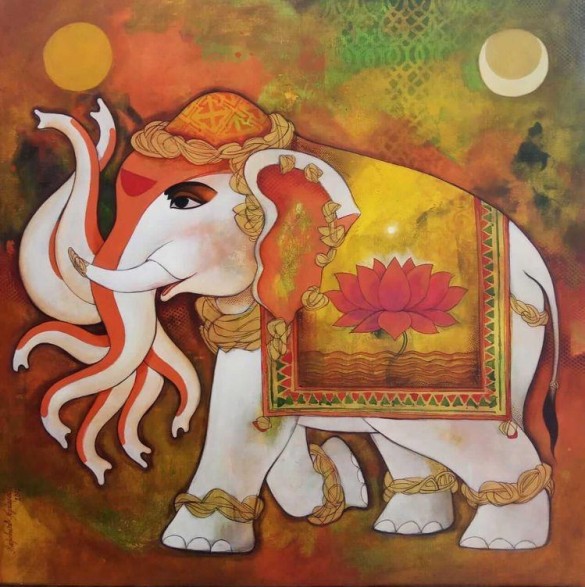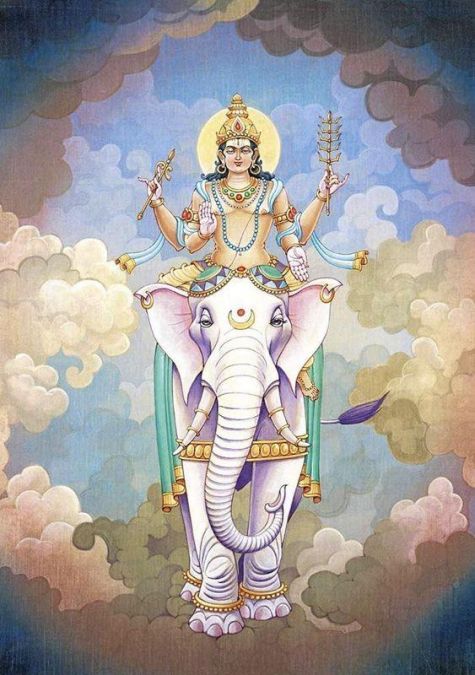
In Hindu mythology, the Airavat Elephant holds a special place as the celestial vehicle of Lord Indra, the king of the demigods. Revered for its immense strength, wisdom, and grace, the Airavat Elephant, also known as the Erawan, Airavata, Ambhramatan and Airavan is an iconic symbol deeply rooted in ancient Indian folklore. This article delves into the fascinating tales and symbolism surrounding Indra's carrier, the Airavat Elephant, exploring its significance, characteristics, and cultural impact. Airavat is said to be white spotless elephant with four tusks and seven trunks.

‘Ira’ in Airavat stands for water and so Airavat is something which emerged from water. It is said that Airavat was one among the fourteen gems originated from Samudra Manthan and so Airavat Elephant originated during the churning of the cosmic ocean, known as the Samudra Manthan. As various gods and demons engaged in this celestial event, a magnificent white elephant emerged from the depths, carrying the elixir of immortality, known as Amrita, in its trunk. This celestial being was none other than the Airavat Elephant, a divine creation embodying purity and power.
ALSO READ - From Matsya to Kalki: Exploring the Epic Journey of Lord Vishnu's 10 Avatars
His wife is said to be Abhramu and the Airavat Elephant is revered for its symbolic representation of strength, wisdom, and fertility. In Hindu iconography, it is often depicted as a pure white elephant with multiple tusks, four tusks being the most common depiction. The white color signifies purity and righteousness, while the multiple tusks symbolize the elephant's divine nature and superiority.
ALSO READ - Bhuloka Vaikuntam - Tirupati Balaji
Known for its exceptional strength, the Airavat Elephant represents the indomitable power of Lord Indra, the god of thunder and rain, who rides upon its back. Additionally, the elephant embodies wisdom, intelligence, and nobility, attributes often associated with Lord Indra himself.
The Airavat Elephant holds great cultural significance in Hinduism and is prominently featured in religious rituals, sculptures, and artwork. In various festivals and processions across India, especially during religious celebrations like Diwali and Ganesh Chaturthi, beautifully adorned elephant idols are paraded through the streets, reminiscent of Lord Indra's celestial carrier.
Moreover, the Airavat Elephant is often associated with fertility and prosperity. In Hindu mythology, it is believed that the presence of the Airavat brings good fortune and abundance. Consequently, it is a revered symbol in many households, with elephant figurines or statues being common decorative elements in homes and temples. While the Airavat Elephant remains an integral part of Hindu mythology, its symbolism and imagery have transcended religious boundaries and found their way into contemporary culture. The Airavat's majestic stature, intelligence, and gentle nature have inspired countless artists, writers, and filmmakers.
ALSO READ - The Ten Enchantments: Divine Tales of Lord Vishnu's Avatars
In modern literature and popular culture, references to the Airavat Elephant can be found in various forms. It serves as a metaphor for wisdom, strength, and overcoming challenges, offering inspiration and guidance to individuals facing obstacles in their lives. The Airavat Elephant, as Indra's celestial carrier, continues to captivate imaginations with its majestic presence and rich mythological significance. Revered for its strength, wisdom, and purity, this divine creature remains an enduring symbol of power and grace in Hindu mythology. Its cultural significance extends beyond religious realms, inspiring awe and admiration in people across the world, and serving as a timeless reminder of the divine qualities inherent in nature's magnificent creations.